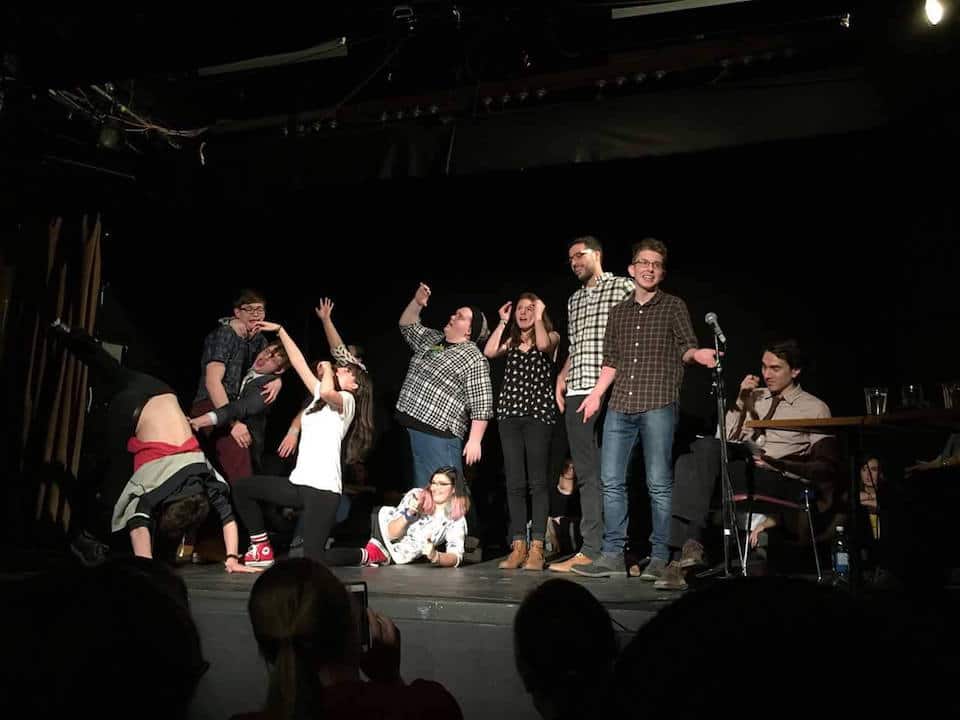“Improv is living on stage,” says Kyle Warne, the vice president of U of T Improv. Warne is speaking about his relationship with improvisational comedy which began in his first year as an undergrad, when he decided it was time to become involved in an art form that had captivated him for years. “Improv is much more than I thought it was.”
Improv is divided into two categories — short-form and long-form. Short-form usually revolves around a preset structure or game, sometimes driven by audience suggestions, whereas long-form is an extended, story-driven approach.
As a competitive improv team, U of T Improv participates in ‘summits’ that bring together teams from across Canada to showcase their comedic styles. The most recent of these took place over ¬¬the weekend of January 22 and featured teams from eight different universities across Ontario and Quebec. The event, held at the Helen Gardiner Phelan Playhouse on campus, was filled to capacity.
Skule Improv is another campus club dedicated to sharing the love of improv. Believe it or not, engineering students have time to run a comedy club, which Candice Lam, a member of the executive team, calls “an extremely common misconception.”
According to Lam, “many engineers are driven to participate and get involved in socially and artistically oriented clubs,” precisely because of their heavy workloads. Although the Skule Improv club has grown out of the engineering society, it remains a “very inclusive” environment for non-engineering students as well. In fact, Lam herself is a health and disease major.
Marisa Di Leo is another member of U of T Improv’s performing team who sought out a way to connect with the improv community in Toronto after transferring from Queen’s University, earlier this year. “I found right away that [the club] was a really great community to be involved with on campus,” she says. Warne agrees that on such a large campus, it’s important to find a niche. “What does every student at U of T have in common, other than going to U of T?” he asks rhetorically. “I’m going with nothing.”
The idea of performing in front of crowds at all, let alone unrehearsed, is terrifying to many people. Fortunately, the improv community is an accepting one. “The environment celebrates mistakes,” Lam says. Similarly, Di Leo says, “improvisers are naturally a very open-minded group of people… we’re taught right away…to listen to each other, and accept what one another is saying.”
So how can students get involved with improv? “It’s difficult to find many things in improv that broke through to mainstream,” Warne says. Unlike stand-up specials or comedy sketches that are easily accessible via Netflix or YouTube, there isn’t an established way of consuming improvisational comedy other than actually going to see improv performances.
Ironically, a great number of famous comics, such as Will Ferrell, Stephen Colbert, and both Tina Fey and Amy Poehler started their careers in improv. As many of these household names progressed to other mediums like sketch comedy, late-night shows, or sitcoms, they left improv behind. Nonetheless, improv theatres continue to serve as recruiting grounds for institutions of comedy.
Students looking to become involved can attend workshops with professional improvisers offered both by Skule and U of T Improv on a regular basis. UTSC and UTM have their own improv clubs as well. Beyond campus, Toronto has “one of the best improv scenes on the continent,” according to Warne. Students who are interested in learning from professional improvisers can also check out the city’s Bad Dog and Second City theatres, both of which offer performances and classes.
However, potential improvisers should take note of its addictive quality. When asked if there’s a moment of his improv career that stands out to him, Warne cites his final performance of his first year at university: a long-form performance known as an ‘improv party.’
In an improv party, all the members of the group are assigned various eccentric characters that happen to be at the same house party and wander in and out of scenes. He describes it all in vivid detail, including a teammate who played a professional air guitarist while miming. “That moment, the end of last year, just looking back, looking at the team… I just felt so much pride at what we’d managed to put together… I really knew on that stage that this was something I was going to want to do for as long as I can.”


